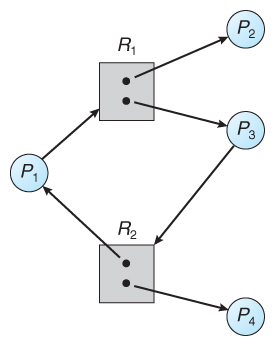A deadlock occurs when two or more processes are waiting indefinitely for an event that can be caused only by one of the waiting processes.
- Four necessary conditions for deadlocks
- Mutual exclusion
- only one process at a time can use a resource
- Hold and wait
- a process holding at least one resource is waiting to acquire additional resources held by other processes
- No Preemption
- a resource can be released only voluntarily by the process holding it, after that process has completed its task
- Circular Wait
- there exists a set {P0, P1, …, Pn} of waiting
processes such that
- P0 is waiting for a resource that is held by P1,
- P1 is waiting for a resource that is held by P2, …,
- Pn–1 is waiting for a resource that is held by Pn,
- Pn is waiting for a resource that is held by P0
- there exists a set {P0, P1, …, Pn} of waiting
processes such that
- Mutual exclusion
A set of vertices V and a set of edges E.
- V is partitioned into two types:
- P = {P1, P2, …, Pn}, the set consisting of all the processes in the system
- R = {R1, R2, …, Rm}, the set consisting of all resource types in the system
- Request edge – directed edge P1 → Rj
- Assignment edge – directed edge Rj → P
- Examples
- If graph contains no cycles ⇒ no deadlock
- If graph contains a cycle ⇒
- if only one instance per resource type, then deadlock
- if several instances per resource type, possibility of deadlock
- Prevention or avoidance
- Ensure that system will never enter a deadlock state
- Ensure that at least one of the necessary conditions never holds
- Have a priori information on how each process will be utilizing the resources to decide whether or not the system is the safe state for each resource allocation.
- Ensure that system will never enter a deadlock state
- Detection
- Allow the system to enter deadlock state, detect it, and then recover
- Ignorance
- Ignore the problem completely assuming that deadlocks never occur in the system.
- used by most operating systems, including UNIX (mostly because overhead)


